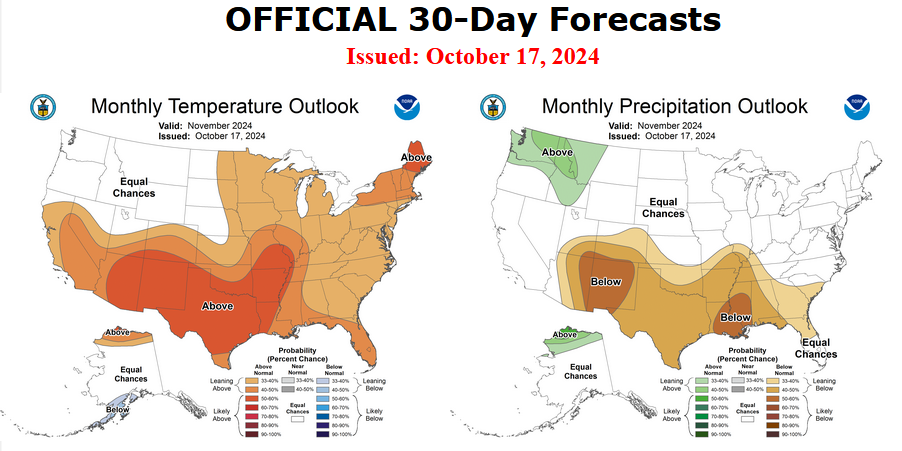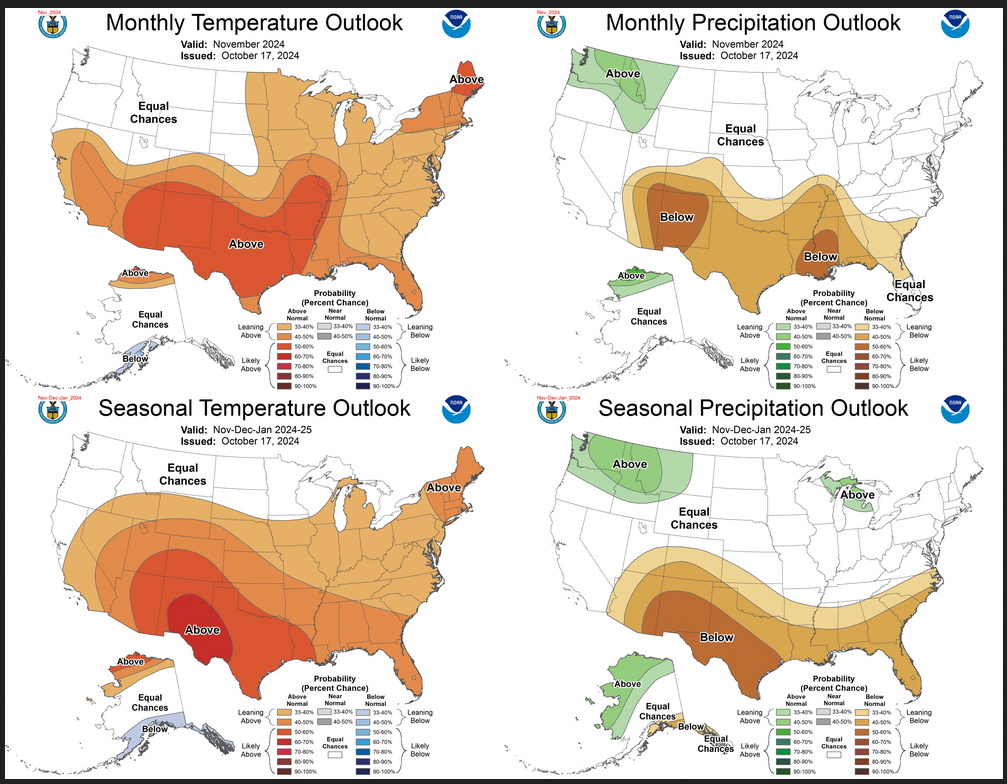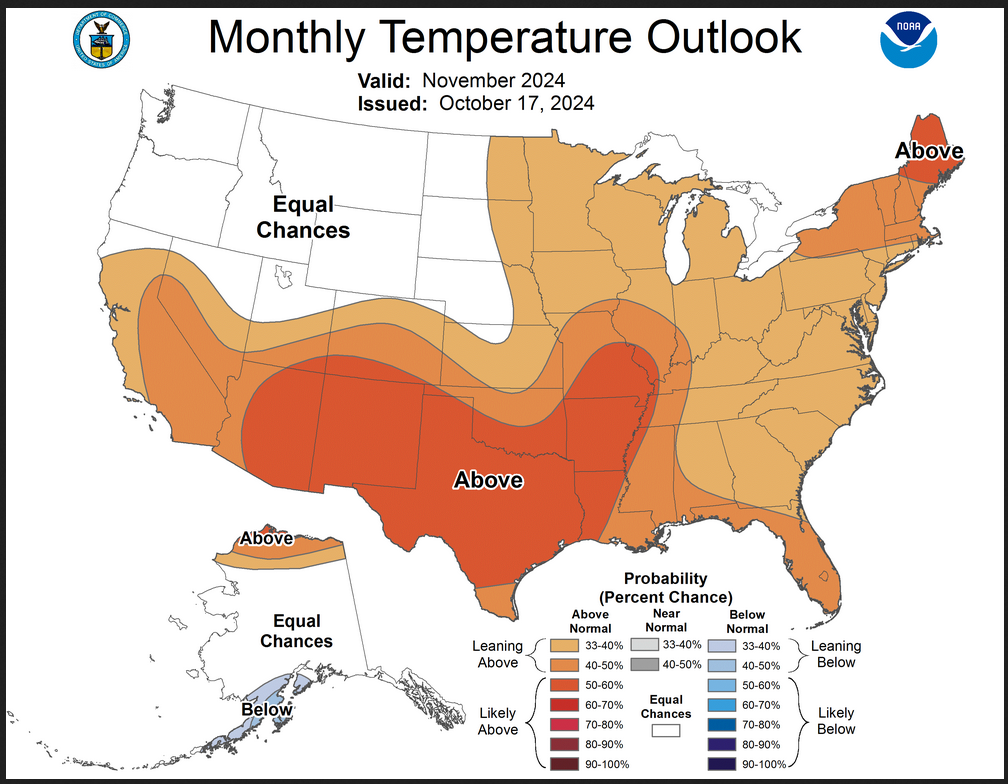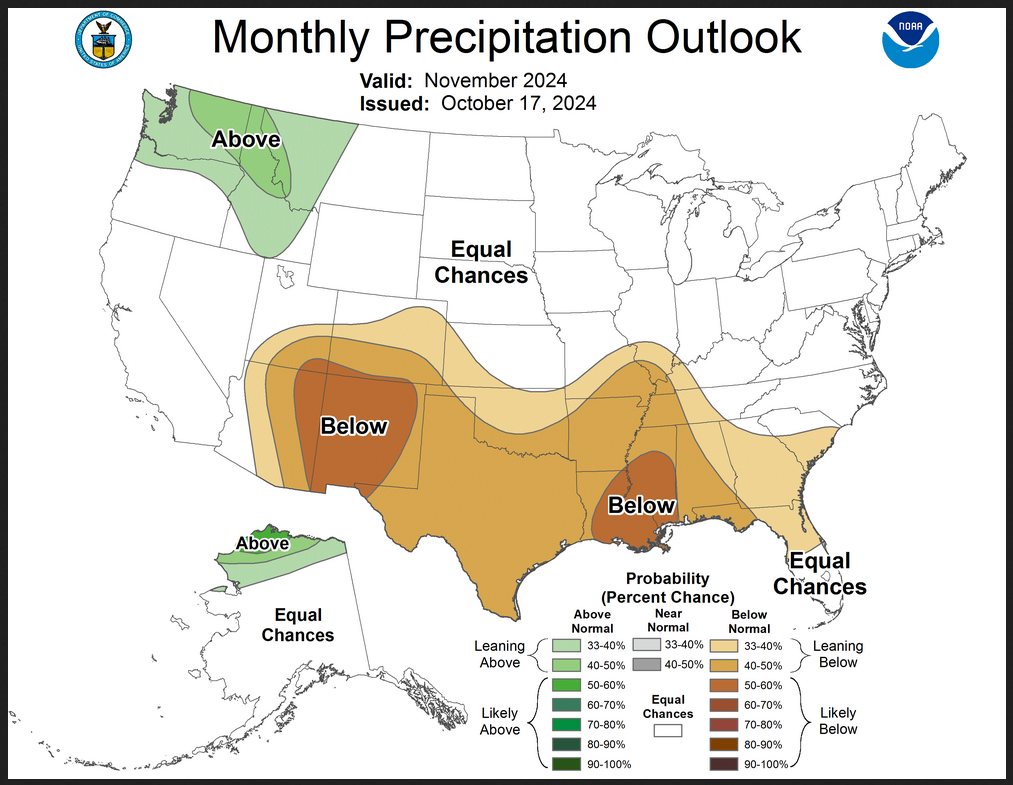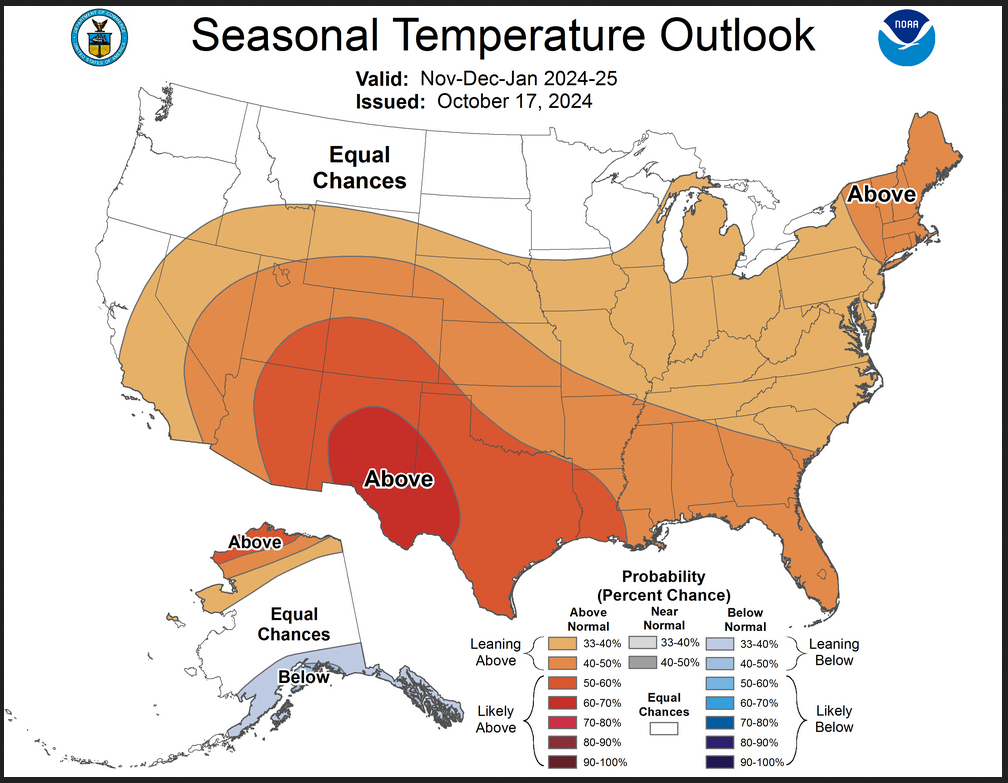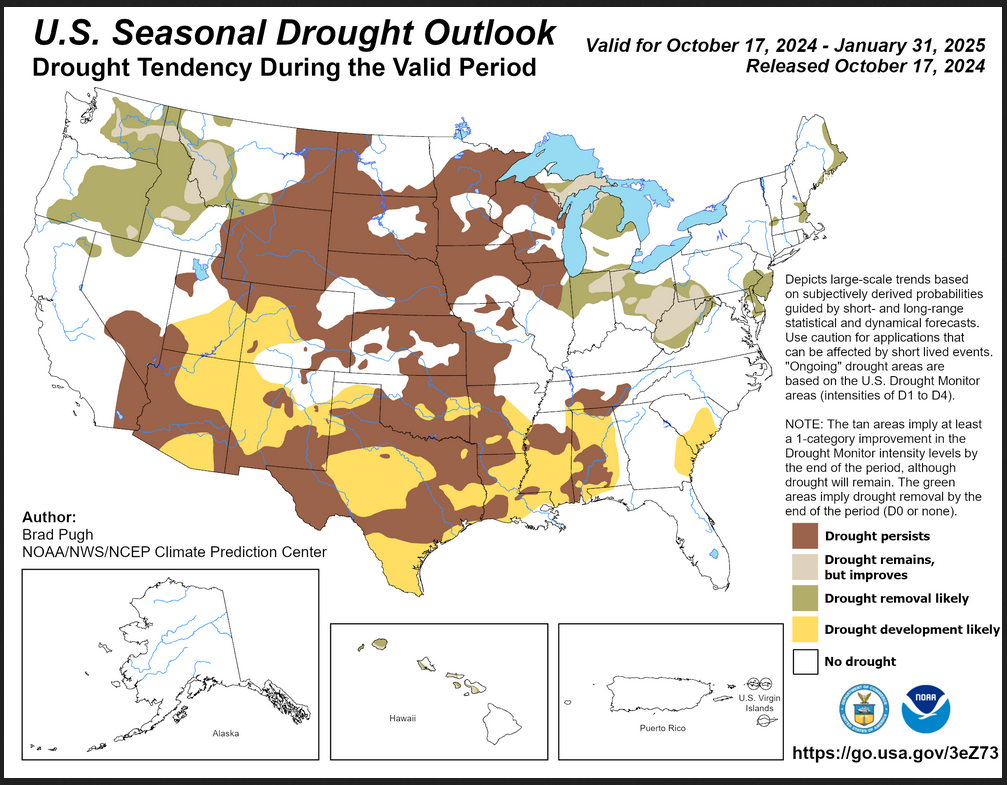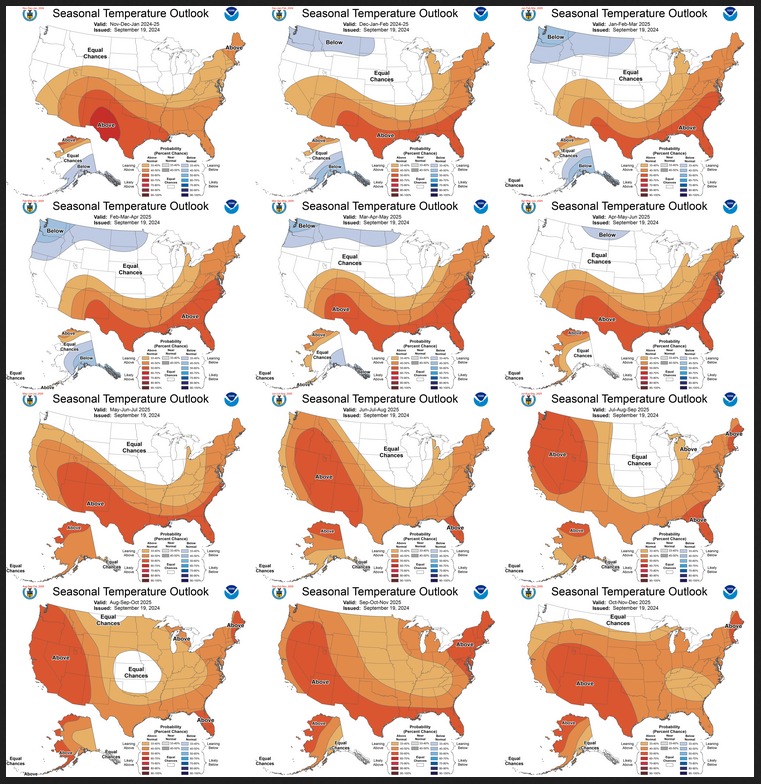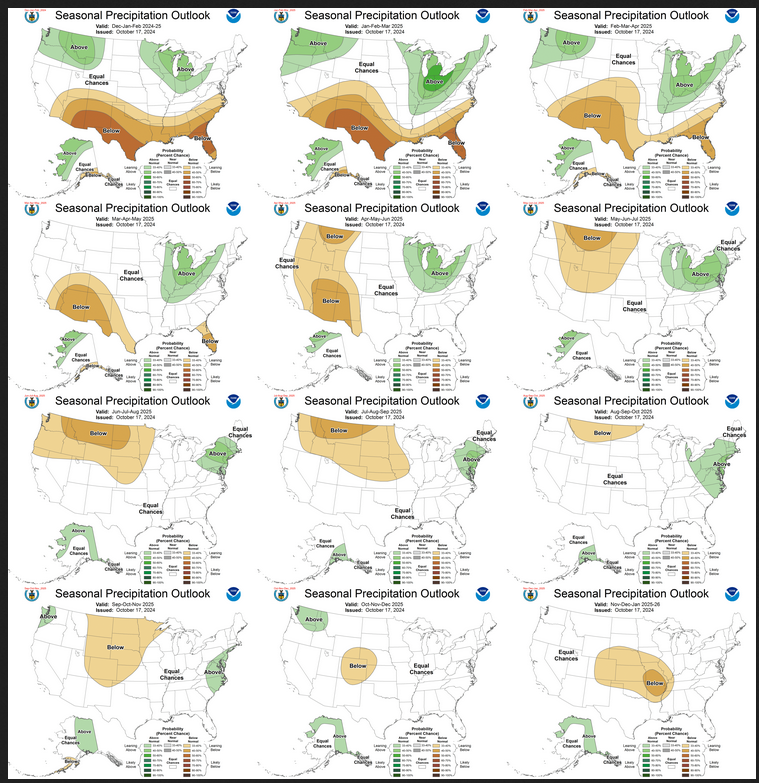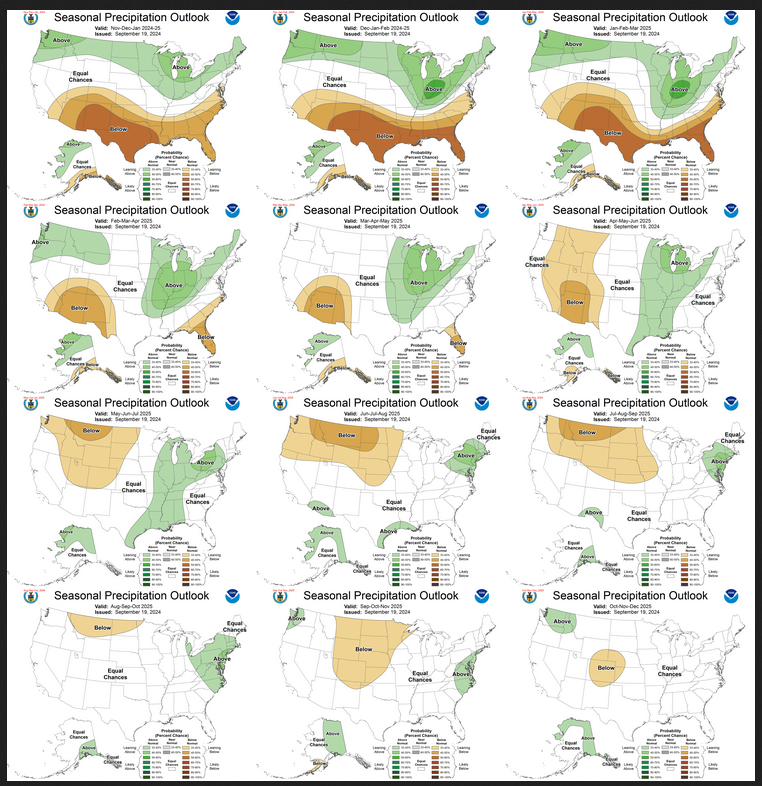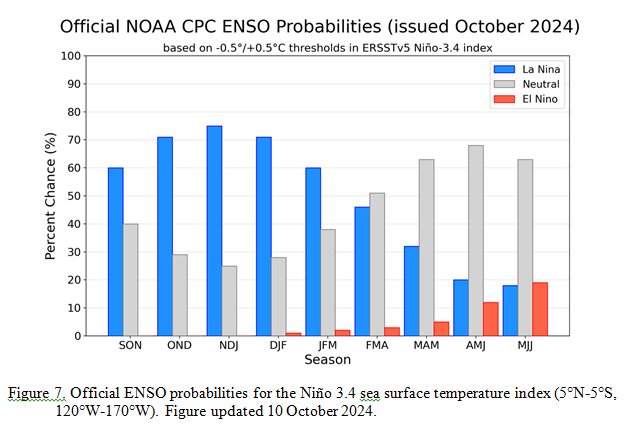On the third Thursday of the month right on schedule NOAA issued their updated Seasonal Outlook which I describe as their Four-Season Outlook because it extends a bit more than one year into the future. The information released also included the Mid-Month Outlook for the following month plus the weather and drought outlook for the next three months. I present the information issued by NOAA and try to add context to it. It is quite a challenge for NOAA to address the subsequent month, the subsequent three-month period as well as the twelve successive three-month periods for a year or a bit more.
With respect to the long-term part of the Outlook which I call the Four-Season Outlook, the timing of the transition from Neutral to LaNina has been challenging to predict. We are still in ENSO Neutral. La Nina is the likely scenario soon, but the strength of the La Nina may be fairly weak..
From the NOAA discussion:
“El Niño Southern Oscillation (ENSO)-neutral conditions remain present, as equatorial sea surface temperatures (SSTs) are near-to-below average in the central and eastern Pacific Ocean. A La Niña Watch remains in effect, with La Niña favored to emerge during September-November (SON) 2024 [Author’s Note: We are halfway through that period and still not in La Nina] (60% chance) [and is forecast to persist through January-March (JFM) 2025. Any La Niña event that develops this autumn is favored, however, to be a weak short duration event.”
I personally would not have total confidence in this outlook given the uncertainty about there actually being a La Nina and its strength if it does happen. I do not have the JAMSTEC outlook yet but for sure they will lean towards a weak La Nina with Modoki characteristics. I do not have a lot of confidence that NOAA knows how to deal with a La Nina Modoki. The number of El Nino and La Nina events since 1950 is a fairly small number. When you further segment them by strength you end up with a very small number of events in each category (El Nino v La Nina and three or four categories of strength within each of perhaps 8 to 10 subcategories. This makes both statistical methods and dynamical models have a large error range. We are pretty confident now that we will have either a weak La Nina or Neutral with a La Nina bias meaning it will be in the Neutral Range but closer to a La Nina than an El Nino. This suggests that there is value in this forecast. The maps show the level of confidence that NOAA (really the NOAA Climate Prediction Center) has for the outlook shown when they show a part of the U.S. or Alaska differing from Normal.
BTW as aside, the NOAA discussion was written this month by my two favorite NOAA Meteorologists.
It will be updated on the last day of October.
Then we look at a graphic that shows both the next month and the next three months.
The top row is what is now called the Mid-Month Outlook for next month which will be updated at the end of this month. There is a temperature map and a precipitation map. The second row is a three-month outlook that includes next month. I think the outlook maps are self-explanatory. What is important to remember is that they show deviations from the current definition of normal which is the period 1991 through 2020. So this is not a forecast of the absolute value of temperature or precipitation but the change from what is defined as normal or to use the technical term “climatology”.
| Notice that the Outlook for next month and the three-month Outlook are fairly similar. This tells us that December and January will be substantially the same as November for most of CONUS and Alaska. Part of the explanation for this is that NOAA expects La Nina to impact all three months. |
–

The full NOAA Seasonal Outlook extends through November/December/January of 2026 (yes that is more than a year out). All of these maps are in the body of the article. Large maps are provided for November and the three-month period November/December/January Small maps are provided beyond that through November/December/January of 2026 with a link to get larger versions of these maps. NOAA provides a discussion to support the maps. It is included in the body of this article.
In some cases, one will need to click on “read more” to read the full article. For those on my email list where I have sent the url of the article, that will not be necessary.
The maps are pretty clear in terms of the outlook.
And here are large versions of the three-month NDJ 2024/2025 Outlooks
First temperature followed by precipitation.
| These maps are larger versions of what was shown earlier. This is a pretty definitive pattern. |
NOAA Discussion
Maps tell a story but to really understand what is going you need to read the discussion. I combine the 30-day discussion with the long-term discussion and rearrange it a bit and add a few additional titles (where they are not all caps the titles are my additions). Readers may also wish to take a look at the article we published last week on the NOAA ENSO forecast. That can be accessed HERE.
I will use bold type to highlight some especially important things. All section headings are in bold type; my comments, if any, are enclosed in brackets [ ].
CURRENT ATMOSPHERIC AND OCEANIC CONDITIONS
ENSO-neutral continued through early October 2024, with near-average sea surface temperatures (SSTs) observed across the equatorial Pacific Ocean as a whole. The equatorial central Pacific SSTs, however, have cooled recently and negative anomalies of greater than -0.5 degrees C for the equatorial region from 165 W to 125 W are evident. In fact, the latest weekly Niño-3.4 index value is now -0.5 degrees C. Below-average subsurface ocean temperatures remain in place with cooler than normal conditions from approximately 160 W to 90 W to a depth of about 150 m. Low-level wind anomalies are easterly over the east-central equatorial Pacific, and upper-level wind anomalies are westerly over the eastern Pacific. Convection has been near average over Indonesia and slightly suppressed over the Date Line.
Then MJO has been active during September into October and aided a trade wind surge across the central Pacific in early September. The MJO is forecast to remain active for at least the rest of October and another trade wind surge supporting cooling of SSTs in the central Pacific is possible in late October.
SSTs at higher latitudes remain warmer than normal for most areas of the mid-Pacific, Atlantic, and Indian Oceans. Enhanced upwelling along the U.S. West Coast has allowed negative SST anomalies to develop in parts of this region and below-normal ocean surface temperatures are evident in parts of the Gulf of Alaska and the Bering Sea.
Drought conditions have rapidly expanded across much of the CONUS during late summer and early autumn especially for areas in the central U.S.
PROGNOSTIC DISCUSSION OF SST FORECASTS
Taken collectively, statistical and dynamical model forecast guidance of the Niño3.4 index favor the development of a weak and most likely short duration La Niña event. Some statistical model forecasts do favor a continuation of ENSO-neutral into and through winter 2024-2025. Dynamical model guidance predictions tend to support weak La Niña conditions to develop, including the majority of participant models from the NMME and C3S forecast suites. Most recent observations and the forecast guidance noted above favor La Niña to emerge during SON (60% chance) and is expected to persist through JFM 2025.
30-DAY OUTLOOK DISCUSSION FOR NOVEMBER 2024
The November 2024 outlook considered the current and projected state of El Niño Southern Oscillation (ENSO), the Madden Julian Oscillation (MJO), trends , and recent Sea Surface Temperatures (SSTs). Tools considered are the Sea Surface Temperature Based Constructed Analog (SST-CA), Canonical Correlation Analysis (CCA), Optimal Climate Normals (OCN), ENSO-OCN blend, and the dynamical models in both the North American Multi-model Ensemble (NMME) and Copernicus Climate Change Services (C3S) suites. Of note, soil moisture was not considered due to the waning influence at this time of year. Further, precipitation measurements over Ontario Canada were deemed unreliable so they were not considered in the analysis of tools for the precipitation outlook.
Temperature
The temperature outlook is close to the consolidation of the statistical tools and NMME, though notably shifted toward a less certain outlook in the Pacific Northwest and Northern Great Plains. The likely progression of the MJO and associated downstream impacts, combined with some analyses showing an over-amplified trend in the many of the dynamical models, leads to less certainty in the Pacific NorthWest and Northern Great Plains. Uncertainty about the temperature outcomes along the mid-Atlantic resulted in lowered probabilities there compared to the final consolidation, as the tools indicate either near- or above-normal temperatures. The only tool indicating below-normal temperatures is a soil moisture based constructed analog, which was not considered due to the time of year. Recent SST changes toward warmer temperatures and climatologically low sea ice favor above-normal temperatures across the North Slope and northwest coast of Alaska. Slightly elevated odds for below-normal temperatures from the Kenai Peninsula to the Alaska Peninsula are consistent with La Niña though only weakly supported in the dynamical models.
Precipitation
The precipitation outlook reflects the consistent signals among the tools and dynamical models. Favoring below-normal precipitation along most of the southern tier is related to the developing La Niña, as well as indicated in most of the tools and dynamical models . The CFS indicates some wetness across the Southern Plains, so probabilities there are lower than the Southwest and the Lower Mississippi Valley. Statistical tools also indicate above-normal precipitation in Kansas and Oklahoma but the dynamical models do not, and calibrations result in very small and uncertain areas. Across the Pacific Northwest, the forecast for above-normal precipitation is supported in the dynamical models (NMME and C3S) and aligns with the emerging La Niña. Above-normal precipitation across Northern Alaska is typically associated with warmer SSTs and lower sea ice. Almost all of the models in the NMME suite have a signal for above-normal precipitation across the north slope, which is retained in the calibrated outlooks.
SUMMARY OF THE OUTLOOK FOR NON-TECHNICAL USERS (Focus on Nov/Dec/Jan)
El Niño Southern Oscillation (ENSO)-neutral conditions remain present, as equatorial sea surface temperatures (SSTs) are near-to-below average in the central and eastern Pacific Ocean. A La Niña Watch remains in effect, with La Niña favored to emerge during September-November (SON) 2024 (60% chance) and is forecast to persist through January-March (JFM) 2025. Any La Niña event that develops this autumn is favored, however, to be a weak short duration event.
Temperature
The November-January (NDJ) 2024-2025 temperature outlook favors above-normal seasonal mean temperatures for most of the Contiguous United States (CONUS) from the Southwest eastward to include most of the central U.S. and all of the eastern CONUS. The largest probabilities (greater than 60 percent) of above normal temperatures are forecast for parts of the Southwest. There also is an enhanced likelihood of above-normal temperatures for northern Alaska. Below-normal temperatures are most likely for much of southern Alaska.
Precipitation
The NDJ 2024-2025 precipitation outlook depicts enhanced probabilities of below-normal seasonal total precipitation amounts along most of the southern tier of the CONUS and for parts of southeast Mainland Alaska and Alaska Panhandle. The greatest odds of below-normal precipitation (greater than 50 percent) are forecast for parts of the Southwest and Southern Plains. Slight tilts toward above-normal precipitation is depicted for parts of the Pacific Northwest, northern Rockies, central Great Lakes, and western and northern Alaska.
Equal chances (EC) are forecast for areas where probabilities for each category of seasonal mean temperatures and seasonal total precipitation amounts are expected to be similar to climatological probabilities.
BASIS AND SUMMARY OF THE CURRENT LONG-LEAD OUTLOOKS
PROGNOSTIC TOOLS USED FOR U.S. TEMPERATURE AND PRECIPITATION OUTLOOKS
The development of potential La Niña conditions in the atmosphere-ocean system in the Pacific contributed to the outlooks from NDJ 2024-2025 through FMA 2025. Although typical La Niña impacts are less likely to occur during a weak event (currently favored), La Niña still tilts the odds in the outlook forecast probabilities. Coastal SSTs and constructed analogue forecasts keyed to current soil moisture anomalies are utilized in preparation of the outlooks at early leads. Dynamical model guidance from the NMME and C3S prediction suites (first 5 and 3 leads respectively), statistical forecast tools, long-term temperature and precipitation trends , and an objective, historical skill weighted combination of much of the above guidance strongly contributed to the final outlooks.
PROGNOSTIC DISCUSSION OF OUTLOOKS – NDJ 2024 TO NDJ 2025
TEMPERATURE
The NDJ 2024-2025 temperature outlook favors above-normal seasonal mean temperatures for much of the contiguous U.S. (CONUS) to include the Southwest, central Rockies, the central and Southern Plains, Southeast, Ohio Valley, mid-Atlantic and Northeast. Highest odds for warmer than normal conditions is forecast for the Southwest and southern Plains. The temperature outlook for this season is primarily based on dynamical model guidance from the NMME and C3S prediction suites and long term positive temperature trends across much of the country.
Expectations for the development of La Niña conditions contributed to the temperature outlooks and their evolution from DJF 2024-2025 through FMA 2025. Even though the La Niña event is favored to be a weak and shorter duration event at this time, typical winter season impacts influence the outlook during these seasons with below-normal temperatures most likely from the Pacific Northwest eastward to the northern Plains beginning in DJF 2024-2025 through FMA 2025 and potentially lingering for parts of the Pacific Northwest and northern Rockies in MAM 2025. Enhanced odds for above-normal temperatures forecast in NDJ 2024-2025 gradually decrease in coverage and magnitude across the CONUS through FMA 2025 for areas of the western CONUS, Midwest, Great Lakes, Ohio Valley and Northeast. Some Statistical model guidance including the ENSO-OCN forecast tool and composites taken over the 1991-2023 period for combined weak La Niña and ENSO-neutral winter seasons support this outlook evolution.
Negative temperature trends for the north-central U.S. – especially centered near the month of February – played a considerable role in the outlooks. The official outlooks deviate significantly in some areas in the north-central CONUS from the majority of the NMME and C3S dynamical model guidance. Given weak ENSO forcing this winter, variability within the winter seasons is most likely to be above-average and greater than last winter. The variance from key subseasonal modes of variability from both the Tropics (e.g., MJO, etc.) and higher latitudes/stratosphere (i.e., AO/NAO, etc.) is likely to dominate the eventual seasonal mean temperature anomalies rather than more persistent periods during the winter. Positive temperature trends in the dynamical model guidance may be overemphasized in the model predictions in these regions resulting in warmer solutions overall for the winter seasons from DJF through FMA 2025 as the observed temperature trends are either neutral or negative in most areas.
For Alaska, over these seasons, dynamical model guidance is in overwhelming agreement between models and consistent with typical La Niña related impacts. Below-normal temperatures are most likely for south-central and Southeast mainland Alaska as well as for the Alaska Panhandle through MAM 2025 with the maximum forecast coverage during JFM 2025. Above-normal temperatures are favored for northwest Alaska during this period with the greatest odds during NDJ 2024-2025 due to more open water (below-normal sea ice extent) and anticipated warmer than normal SSTs.
Progressing through the spring and summer months of 2025, the outlooks primarily rely on the forecast consolidation of statistical model guidance and long-term temperature trends with high uncertainty in the future evolution of ENSO. Forecast coverage for above-normal temperatures is greatest during the late spring and summer seasons of MJJ and JJA 2025.
PRECIPITATION
The NDJ 2024-2025 precipitation outlook favors above-normal seasonal total precipitation amounts for portions of the Pacific Northwest, northern Rockies, Michigan, and northern and western Alaska. Drier-than-normal conditions are most likely for the southern tier of the U.S. with the highest odds forecast for the Southwest and Southern Plains. For Southeast Mainland Alaska and the northern Alaska Panhandle, a slight tilt toward drier than normal conditions is forecast through MAM 2025.
As noted above, the favored development of La Niña conditions approaching the winter and consistent dynamical model forecast guidance is the basis for the outlook. Moving through the FMA 2025 season, the enhanced likelihood of above-normal precipitation in the Great Lakes and Ohio Valley regions expands in coverage and probabilities increase maximizing in the southern Great Lakes and northern Ohio Valley area in JFM 2025. Positive precipitation trends also contribute strongly to these outlooks for some areas in the Midwest and Great Lakes.
Favored below-normal precipitation across the south through FMA 2025 remains generally consistent with the forecast coverage and odds greatest for JFM 2025. The majority of the dynamical model guidance from the NMME and C3S model suites highlight substantially elevated odds for below-normal precipitation for the Far West (i.e., California/Nevada) for the winter seasons through FMA 2025. Given the anticipated generally weak ENSO forcing, this seems overdone, especially since some of the dynamical model guidance can sometimes overemphasize ENSO impacts during weaker events. [Author’s note: Will this turn out to be the case also for Arizona, New Mexico and Texas also?]
Given the lack of a clear, reliable ENSO signal after this winter/early spring, longer lead outlooks are primarily based on long term precipitation trends and depict low forecast coverage. The longer lead precipitation outlooks during the warm season generally have low forecast skill. [It is too soon to have informed opinions on the Monsoon in 2025.
Drought Outlook
| The yellow is the bad news and there is a lot of it. And there is a large area where drought is expected to persist. The area where drought is expected to improve is also fairly large. With a La Nina winter ahead, Drought is likely to expand in parts of the Southern Tier of states. Overall the level of drought is expected to increase slightly. |
Short CPC Drought Discussion
Latest Seasonal Assessment – Drought coverage expanded and intensified across much of the Great Plains and Midwest during the summer and into the early fall. Based on the November-December-January (NDJ) outlook favoring below-normal precipitation and above-normal temperatures, additional drought development is forecast for the Southern Great Plains, Lower Mississippi Valley, and portions of Southeast. Heavy rainfall, associated with Hurricane Helene, precludes a larger coverage of development across the Southeast. However, if La Niña becomes well-established by this winter, then more of the Southeast could have an increasing chance of development. Development is also favored for parts of the Southwest which is consistent with antecedent dryness and the NDJ outlook. A wet climatology along with a tilt towards above-normal precipitation from late October through the end of January support drought improvement or removal across the Pacific Northwest and northern Intermountain West.
Drought persistence is likely throughout the Great Plains and Upper Mississippi Valley as these areas enter a dry time of year. Based on the NDJ outlook favoring above-normal precipitation, drought improvement or removal is forecast for most of Michigan. Improvement and removal are also expected across the Ohio Valley and Central Appalachians by the end of January, given the favorable time of year for soil moisture recharge and equal chances of below, near, or above-normal precipitation during NDJ. Drought is anticipated to eventually end for portions of the Mid-Atlantic and New England during the next few months.
Alaska, Hawaii, Puerto Rico, and the U.S. Virgin Islands are likely to be nearly or completely drought-free at the end of January
Looking out Four Seasons.
Twelve Temperature Maps. These are overlapping three-month maps (larger versions of these and other maps can be accessed HERE)
Notice that this presentation starts with Dec/Jan/Feb (DJF) since NDJ is considered the near-term and is covered earlier in the presentation. The changes over time are generally discussed in the discussion but generally, you can see the changes easier in the maps. The discussion often provides the “why” and how the outlook might be different than what was issued last month.
Comparing the new outlook with the prior Outlook,
The easiest way to do the comparison is to print out both maps. If you have a color printer that is great but not needed. What I do is number the images from last month 1 – 12 starting with “1” and going left to right and then dropping down one row. Then for the new set of images, I number them 2 – 13. That is because one image from last month in the upper left is now discarded and a new image on the lower right is added. Once you get used to it, it is not difficult. In theory, the changes are discussed in the NOAA discussion but I usually find more changes. It is not necessarily important. I try to identify the changes but believe it would make this article overly long to enumerate them. The information is here for anyone who wishes to examine the changes. I comment below on some of the changes from the prior report by NOAA and important changes over time in the pattern.
| There has not been much of a change since last month. |
Similar to Temperature in terms of the organization of the twelve overlapping three-month outlooks.
Comparing the new outlook with the prior Outlook,
The maps that were released last month.
A good approach for doing this comparison is provided with the temperature discussion.
| The overall outlook is pretty much the same as last month. |
| It looks like ENSO is Neutral now however we should be in La Nina any day now. This type of graphic does not show how strong an El Nino or a La Nina is likely to be. What is forecast is a La Nina, which if it does occur, most likely will not be stronger than a marginal La Nina. |
Resources
Other Reports and Information
The Wildfire Report can be accessed HERE
–
| I hope you found this article interesting and useful. |
–
